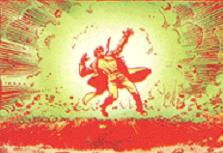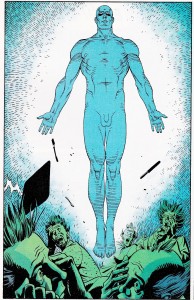[Don’t forget, if you haven’t, you can sign up for apoplectic.me updates and bonus material here.]
If there’s one unifying theme to apoplectic.me, it’s love. And Python references. And transformation. In the wake of Stroke Bloke: Year One and my consideration of The Batman, I’ve been looking at some other origin stories. Like The Hulk and Dr. Manhattan of The Watchmen.

And the common thread in these stories is that something horrific happens to each of these characters, that triggers his change into the post-trauma character. The Hulk’s been around for a while, of course. Batman more so, although his story keeps being retold. The Watchmen less so, but even if the movie is only four years old, the comic book is 26. Regardless, there’s something about the trope of the epiphany through adversity that seems to appeal to modern audiences.

Extreme transformation is not a new idea, of course. Particularly in these days of the dark and interesting superheros, each of these stories carries echoes of Robert Louis Stevenson. With Clermiston Tower, erected in memory of Walter Scott, just up Corstorphine Hill, and the steampunk rocket of the Scott Monument dominating Princes Street Gardens in the city centre, Stevenson has laboured somewhat in the shadow of the author of Waverley. Perhaps this is an ongoing effect of Scott’s position as a member of the establishment, while Stevenson, despite — because of — being an unwell man, travelled widely, and chose not to employ his law degree, having been more enamoured as a teenager of the seediness and seaminess of the Old Town at night.

Perhaps now, though, the tables are turning in favour of this pre-modern, modern man. 2007 saw Steven Moffat’s modernised version of the Strange Case Of Dr Jekyll And Mr Hyde aired to some acclaim. In 2008, as part of Edinburgh’s ongoing work as the first, permanent, UNESCO City Of Literature (a designation bestowed in 2004), thousands of free copies of Dr Jekyll And Mr Hyde were distributed around the city. In his introductory appreciation, Ian Rankin acknowledges that the first two Inspector Rebus novels “borrowed heavily from Stevenson as I attempted to show contemporary Edinburgh as a schizophrenic city, not much changed since Stevenson’s time.”
Just last month, Rankin unveiled a bronze sculpture of Stevenson in a garden in the Colinton area of Edinburgh. RLS Day 2013 was recently celebrated on the author’s birthday, 13 November. Visit Scotland noted that the modern, charitable hipster could find an appropriate “mo bro” to salute for Movember, in Stevenson:
In addition to penning such classic works as Treasure Island, Kidnapped, Catriona and The Strange Case of Dr Jekyll and Mr Hyde, the masterful storyteller was also known for sporting bohemian velvet attire and an extremely dapper moustache which you too can don (albeit a paper cut-out one you can download) on Robert Louis Stevenson Day 2013 which takes place 13 November, the date of his birthday.

Blackhall Library had a table devoted to his work to celebrate RLS Day, so I picked up a copy of the Strange Case, as well as a collection of An Old Song (“a newly discovered long story”) and the Edifying Letters Of The Rutherford Family (“a previously unpublished short story”).
For me, and I suspect, a lot of other people, Jekyll And Hyde seems like an oft-told, weel-kent story, so it’s a bit of a shock to find how much is packed into its 130-odd pages. It’s not just that themes of the book that seem modern. The structure, too, anticipates the labyrinthine structures (like dark London streets) of Jorge Luis Borges, just as the themes predict Borges’ contribution to fantasy and magic realism.
Lloyd Osbourne, Stevenson’s stepson, wrote that after knocking out the first draft of the Strange Case in three days and (possibly apocryphally) burning it in the grate, the writer feverishly wrote the final version in a further six days while confined to bed with a haemorrhage.
The mere physical feat was tremendous and, instead of harming him, it roused and cheered him inexpressibly.
The cremation of the first draft occurred after Stevenson’s wife had provided thoughts and comments, as was their tradition. Rankin speculates that “it is possible that Fanny disliked that first version because she saw too much of her husband in it.” A few pages earlier in this appreciation, he writes:
. . . there is always the danger that one day a certain voice may be so seductive that the writer is unable to return to the real world. The characters we create can not only haunt us . . . they can also transform us.
Stevenson’s feat, it appears to me, is a purging. But can one create a new self — not an ogre, but something more aspirational — through trauma and the power of imagination?






See and here I was thinking python is call-by-object not pass-by-reference.
Anyway, books, places. I’m in India right now which makes me think of White Tiger (http://www.amazon.com/The-White-Tiger-A-Novel/dp/1416562605).
I agree with you. Fiction, place, trauma, experience. These are all intertwined in our best writing. That’s absolutely true. It leads to a very long reading list, but let me limit it to the one above before I go get in my car across town to work.
Ah. I see what you did there. Well, I had to look it up first. And I don’t fully understand it. But the M. Python troupe dominated the BBC news today with their reformation press conference.
Hope India went/is going well. Looks lovely. White Tiger added to the rapidly-expanding reading list.
Weirdly, of all the famous people I can think of from Rhode Island, no writers spring to mind. Unless you count Don Bosquet (and I definitely do).
Well, after a bit of research, I get Don Bosquet about as much as I get Paul’s comment. But I will say this: Lemme have a lodge chowda wit milk, a dozen cleeam cakes an’ a couple shaw dinnizz. Also, Reggie Bosanquet!
Cremating a first draft sounds incredibly exciting. And terrifying. As many good things are.
Goodness, yes. Impossibly exciting. And speaking of incredibly exciting, and talking of good things…. Rip it up and start again. http://www.youtube.com/watch?v=ESy-Z8vqMrE